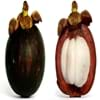Health Benefits
Good for diabetics, Improves well-being, Miraculin/miracle fruit makes sour things taste sweet
Cancer prevention, Cures gastro-intestinal troubles, Improves night vision, Improves stomach health, Prevents diabetes, Prevents high blood pressure, Reduces blood circulation problems
General Benefits
Has taste modifying effect
Fights against infections, Helps in weight loss, Prevents blood clotting in vessels, Treatment of urinary tract infections
Skin Benefits
NA
Anti-aging benefits, Nourishes skin, Protects against skin damage
Hair Benefits
NA
Prevents hair loss
Allergy Symptoms
Itching, Skin rash
Not Available
Side Effects
Changes taste of food eaten after this fruit, Coagulation
Decrease in blood sugar levels, Diarrhoea, Dizziness, Headache, Internal bleeding, Stomach pain
Best Time to Eat
As a snack in the late afternoon, Eat the fresh ones, avoid mixing with any other foods, don't eat after meal., Morning time (before lunch)
As a snack in the late afternoon, Don't consume at night and before bed, Eat the fresh ones, avoid mixing with any other foods, don't eat after meal., Morning time (before lunch)
Protein to Carb Ratio
Not Available
Vitamin A (Retinol)
Not Available
Vitamin B1 (Thiamin)
Not Available
Vitamin B2 (Riboflavin)
Not Available
Vitamin B3 (Niacin)
Not Available
Vitamin B5 (Pantothenic Acid)
Not Available
Vitamin B6 (Pyridoxin)
Not Available
Vitamin B9 (Folic acid)
Not Available
Vitamin C (Ascorbic Acid)
Vitamin K (Phyllochinone)
Not Available
Lutein+Zeaxanthin
Not Available
Water Content
Not Available
Calories in Fresh Fruit with Peel
Not Available
Calories in Fresh Fruit without Peel
Not Available
Not Available
Calories in Frozen Form
Not Available
Not Available
Calories in Dried Form
Not Available
Not Available
Calories in Canned Form
Not Available
Not Available
Calories in Juice
Not Available
Calories in Jam
Not Available
Calories in Pie
Not Available
Varieties
Gymnema Sylvestre and Thaumatococcus Daniellii
Dwarf bilberry, Piper, bog blueberry, Northern bilberry, Mountain bilberry and Oval-leaved bilberry
Color
Dark red
Dark purple
Inside Color
Greyish-white
Light Green
Origin
West Africa
Unknown
Soil Type
Well-drained
Moist, Well-aerated
Climatic Conditions
Rainfall
Cold
Facts about
- The name 'Miracle' because of the magical experience you get after eating it.
- When you have lemon after eating this fruit, it tastes sweet as if it is added with sugar.
- It is also used as natural sweetener.
- Bilberries are used in manufacturing of alcoholic drinks.
- They are used to improve aromas of sorbets.
- The green extract of it's leaves is used in textile industry as natural dye.
Other Countries
NA
Denmark, Finland, Iceland, Sweden
Top Importer
Not Available
United States of America
Top Exporter
United States of America
Chile
Botanical Name
Synsepalum Dulcificum
Vaccinium myrtillus
Synonym
Miracle Berry, Miraculous Berry and Sweet Berry
blaeberry, whinberry, European blueberry, whortleberry
Subkingdom
Tracheobionta
Tracheobionta
Division
NA
Magnoliophyta
Subclass
Asteridae
Dillenhidae
Family
Sapotaceae
Ericaceae
Genus
Synsepalum
Vaccinium
Species
S. dulcificum
Vaccinium myrtillus
Generic Group
Not Available
Heath
Difference Between Miracle fruit and Bilberry
We might think that Miracle fruit and Bilberry are similar with respect to nutritional value and health benefits. But the nutrient content of both fruits is different. Miracle fruit and Bilberry Facts such as their taste, shape, color, and size are also distinct. The difference between Miracle fruit and Bilberry is explained here.
The amount of calories in 100 gm of fresh Miracle fruit and Bilberry with peel is Not Available and 44.00 kcal and the amount of calories without peel is Not Available and Not Available respectively. Thus, Miracle fruit and Bilberry belong to Low Calorie Fruits and Low Calorie Fruits category.These fruits might or might not differ with respect to their scientific classification. The order of Miracle fruit and Bilberry is Ericales and Ericales respectively. Miracle fruit belongs to Sapotaceae family and Bilberry belongs to Ericaceae family. Miracle fruit belongs to Synsepalum genus of S. dulcificum species and Bilberry belongs to Vaccinium genus of Vaccinium myrtillus species. Beings plants, both fruits belong to Plantae Kingdom.









